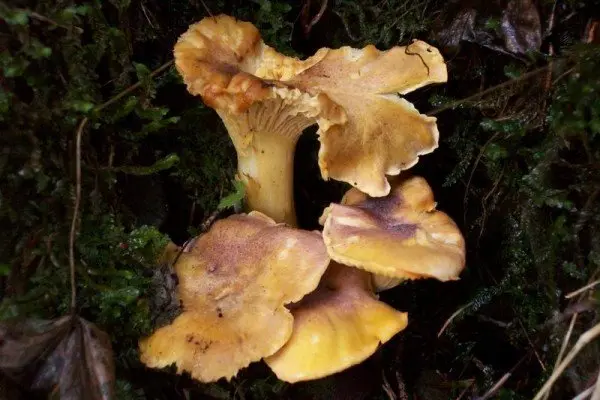Contents
Chanterelle amethyst (Cantharellus amethysteus)
- Division: Basidiomycota (Basidiomycetes)
- Subdivision: Agaricomycotina (Agaricomycetes)
- Class: Agaricomycetes (Agaricomycetes)
- Subclass: Incertae sedis (of uncertain position)
- Order: Cantharellales (Chanterella (Cantarella))
- Family: Cantharellaceae (Cantharellae)
- Genus: Cantharellus
- Type: Cantharellus amethysteus (Amethyst chanterelle)

Chanterelle amethyst (Cantharellus amethysteus) is a mushroom of the agaric class, the chanterelle family.
External description of the fungus
The stem of the mushroom has a cylindrical shape, high density, smooth surface. The stem is slightly narrowed at the bottom, and widens at the top. Its dimensions are 3-7 * 0.5-4 cm. The diameter of the cap of the amethyst chanterelle (Cantharellus amethysteus) varies between 2-10 cm. In a young mushroom, the cap has a slightly convex shape, but most often it is characterized by high density, a wrapped edge, a flat fleshiness. In mature mushrooms, the cap takes on a funnel shape, light yellow or rich yellow hue, wavy edge, has many plates. Initially, the flesh of the cap has a yellowish tint, but gradually turns white, becomes dry, elastic, like rubber, very dense. The taste qualities of amethyst chanterelle are characterized by high quality, slightly reminiscent of the taste of dried fruits. Lamellar-shaped veins descend from the cap down the stem. They are characterized by a yellowish color, branching, large thickness, rare location and low height. Chanterelle of the species Cantharellus amethysteus occurs in two varieties, namely, amethyst (amethysteus) and white (pallens).
Habitat and fruiting season
Chanterelle amethyst (Cantharellus amethysteus) begins to bear fruit in early summer (June) and the fruiting period ends in October. The fungus is common in the wooded areas of Our Country, mainly the amethyst chanterelle can be seen in coniferous, deciduous, grassy, mixed forests. This fungus also prefers not too dense mossy areas of the forest. Often forms mycorrhiza with forest trees, in particular – beech, spruce, oak, birch, pine. The fruiting of the amethyst chanterelle is distinguished by its mass character. Chanterelles come across to mushroom pickers only in colonies, rows, or circles, which experienced mushroom pickers called “witch”.
Edibility
Amethyst chanterelle (Cantharellus amethysteus) belongs to the category of edible mushrooms, with excellent taste. The mushroom does not impose special requirements for transportation, it is well preserved. Chanterelles almost never have worms, so this mushroom is considered kosher. Amethyst chanterelles can be dried, salted, used fresh for frying or boiling. Sometimes the mushroom is frozen, but in this case it would be better to boil it first to remove the bitterness. The beautiful orange color of chanterelles can be preserved even after boiling, if a little lemon juice is added to the water at the time of boiling.

Similar species, distinctive features from them
The amethyst chanterelle (Cantharellus amethysteus) is very similar in shape and color to the classic yellow chanterelle. In fact, this fungus is a subspecies of the yellow chanterelle, but it is distinguished by vein-shaped plates with many lintels and a lilac shade of the fruiting body. The aroma and taste of the amethyst chanterelle is not as strong as that of yellow chanterelles, but the flesh of the fungus is yellowish. Amethyst chanterelle forms mycorrhiza, most often with beeches, sometimes with spruces. You can rarely meet this kind of yellow chanterelle, and only in the forests located in the south of the country.
Chanterelle, pale in appearance, is a bit like amethyst, but differs in a characteristic mealy-white color, through which yellow color noticeably breaks through. It grows in the same area with yellow and amethyst chanterelles, it is very rare.
Medicinal properties
Amethyst chanterelle is characterized by excellent medicinal properties. Its use in food helps to increase the body’s resistance to colds, increase immunity, raise tone, and cope with dermatitis. Funnel-shaped mushroom helps fight cancer cells, has a powerful bactericidal and antiviral effect.
The fruiting body of amethyst chanterelles in its composition contains a large amount of vitamins, including B1, B2, B3, A, D2, D, C, PP. This mushroom also contains trace elements in the form of copper and zinc, acids important for the body, carotenoids with an antioxidant effect.
If amethyst chanterelles are constantly eaten, it will help improve vision, prevent inflammatory diseases in the eyes, remove dry skin and mucous membranes. Experts from China also recommend including chanterelles in your diet for those who constantly work at the computer.
The composition of amethyst chanterelles and similar species contains a special substance ergosterol, characterized by its active effect on liver enzymes. Chanterelles are recommended for use by everyone who suffers from liver diseases, hemangiomas, and hepatitis. According to recent studies, the hepatitis virus is negatively affected by trametonolinic acid. This polysaccharide is found in sufficient quantities in chanterelle mushrooms.
The fruit bodies of the amethyst chanterelle can be infused with alcohol, and then used for medicinal purposes, to prevent the development of cancer cells in the body. With the help of chanterelles, you can also get rid of helminthic invasions. Perhaps this is due to the enzyme chitinmannose, which is one of the natural anthelmintics. An interesting fact is that in Latvia chanterelles are used to effectively treat tonsillitis, tuberculosis, and furunculosis.









